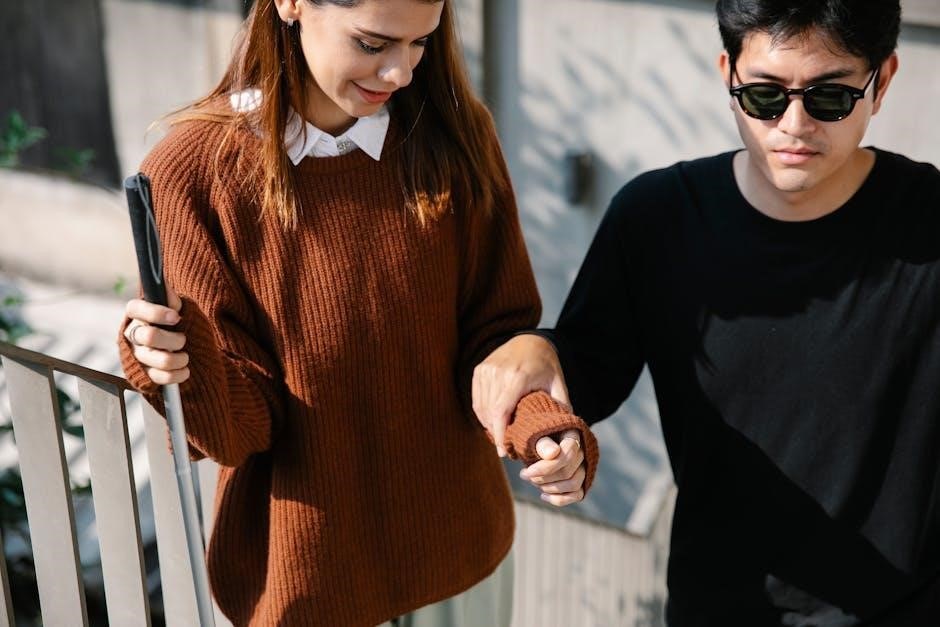Hognose snakes are popular pets due to their unique upturned snouts and fascinating behaviors. Native to North America, they are known for their calm nature and ability to “play dead” when threatened. With proper care, including a suitable enclosure, balanced diet, and appropriate temperature and humidity levels, these snakes thrive in captivity. Understanding their specific needs ensures a rewarding experience for both novice and experienced reptile enthusiasts.
Overview of Hognose Snakes as Pets
Hognose snakes are increasingly popular as pets due to their calm demeanor and unique appearance. They are known for their upturned snouts and impressive defensive behaviors, such as “playing dead” when threatened. These snakes are relatively small, easy to handle, and adapt well to captivity, making them a great choice for both novice and experienced reptile enthusiasts. Their attractive color patterns and docile nature further enhance their appeal. With proper care, hognose snakes can thrive in a home environment, providing an engaging and rewarding pet experience for those interested in reptiles.
Importance of Proper Care and Husbandry
Proper care and husbandry are crucial for the health and well-being of hognose snakes. Maintaining the right enclosure conditions, including temperature, humidity, and substrate, ensures their environment remains safe and conducive to their natural behaviors. A balanced diet tailored to their carnivorous needs, along with regular feeding schedules, supports optimal growth and health. Cleanliness and proper hygiene practices prevent the risk of disease, while appropriate enrichment activities keep the snakes mentally stimulated. Neglecting these aspects can lead to stress, health issues, and a shorter lifespan. By prioritizing proper care, owners can help their hognose snakes live happy and thriving lives in captivity.

Species-Specific Care
Western, eastern, and southern hognose snakes have distinct care requirements. Each species demands tailored habitat setups, dietary preferences, and environmental conditions to thrive in captivity effectively.
Western Hognose Snake Care
Western hognose snakes are popular pets due to their docile nature and attractive patterns. They require a clean, well-ventilated enclosure with a substrate like aspen or reptile carpet. Spot cleaning daily and full cleaning weekly is essential for their health. These snakes thrive in a temperature gradient of 70-75°F for the cool zone and 85-90°F for the basking area. Humidity should be maintained between 30-50%. Their diet consists mainly of pinkie mice for hatchlings, progressing to larger prey as they grow. Providing a shallow water bowl and hiding places is crucial. Proper care ensures these snakes remain healthy and active in captivity.
Eastern Hognose Snake Care
Eastern hognose snakes are known for their dramatic defensive behaviors, such as rolling over and playing dead. They thrive in a well-maintained enclosure with a temperature range of 70-75°F for the cool zone and 85-90°F for basking. Humidity levels should be kept between 30-50%. Their diet primarily includes small mammals, like mice, and occasionally birds. A clean environment is crucial, with daily spot cleaning and a full enclosure cleaning weekly. Providing adequate hiding places and a shallow water bowl is essential. These snakes are active and fascinating to observe when properly cared for, making them a unique and rewarding pet choice for reptile enthusiasts.
Southern Hognose Snake Care
Southern hognose snakes are popular for their striking appearance and calm demeanor. Their care requires a well-ventilated, secure enclosure with a temperature gradient of 70-75°F for the cool zone and 85-90°F for basking. Humidity should be maintained between 30-50%. They prefer a substrate like wood shavings or paper towels, avoiding loose materials that may cause respiratory issues. Their diet includes small mammals and occasional lizards. A shallow water bowl is essential, and daily spot cleaning helps maintain hygiene. Providing hiding places and visual barriers reduces stress. Southern hognose snakes are active and curious, making them a delightful choice for reptile enthusiasts who provide proper care and attention.

Habitat Setup
A well-ventilated, secure enclosure with adequate space is essential for hognose snakes. Maintain a temperature gradient of 70-75°F (cool zone) and 85-90°F (basking area) using heat bulbs or mats. Substrate options like wood shavings or paper towels are ideal, avoiding loose materials that may cause respiratory issues. Proper humidity levels (30-50%) and a shallow water bowl are necessary. Ensure hiding places and visual barriers to reduce stress, promoting a natural environment for your pet hognose snake to thrive.
Enclosure Size and Type
For adult hognose snakes, a 2x3x4-foot enclosure is recommended, providing ample space for movement and exploration. Hatchlings can start in smaller enclosures (12-18 inches long) and graduate to larger ones as they grow. A well-sealed, wooden vivarium is ideal, as it retains heat and humidity effectively. Avoid open-topped enclosures, as hognose snakes are excellent escape artists. Ensure the enclosure is secure and escape-proof, with adequate ventilation to prevent respiratory issues. The enclosure should also offer enough space for a temperature gradient and hiding places, which are essential for the snake’s stress reduction and overall well-being. Proper sizing and type are critical for a healthy environment.
Substrate Recommendations
For hognose snakes, a safe and easy-to-clean substrate is essential. Reptile carpet, newspaper, or paper towels are ideal options, as they are non-abrasive and minimize the risk of respiratory issues. Avoid using loose substrates like sand, wood shavings, or calcium sand, as they can cause impaction or respiratory problems. The substrate should be easy to spot-clean and completely replaced every 2-3 months to maintain hygiene. A humidity-retentive substrate like sphagnum moss can be used in moderation, but it must be kept dry to prevent mold growth. Proper substrate choice helps ensure the health and comfort of your hognose snake.
Temperature Requirements
Hognose snakes require a temperature gradient to regulate their body heat effectively. The basking spot should be maintained at around 32°C (90°F), while the cooler end of the enclosure should stay between 22-25°C (72-77°F). A temperature gradient is crucial for thermoregulation, allowing the snake to adjust its body temperature as needed. Avoid extreme fluctuations, as they can stress the snake. Use a reliable heat source, such as a halogen heat bulb, and monitor temperatures closely with a thermometer. Proper temperature maintenance is vital for the snake’s metabolism, digestion, and overall health. Ensure the enclosure provides a consistent and safe thermal environment for your hognose snake to thrive.
Humidity Levels
Hognose snakes prefer moderate humidity levels, typically between 30-50%. Maintaining this range is essential for their shedding process and overall skin health. Avoid high humidity, as it can lead to respiratory issues. Use a hygrometer to monitor levels and lightly mist the enclosure as needed, especially during shedding cycles. Proper ventilation is key to preventing moisture buildup. A well-balanced humidity level ensures your hognose snake remains comfortable and thrives in its environment. Consistency is crucial, as sudden changes can stress the snake. Keep the habitat clean and dry to promote a healthy, thriving pet.

Diet and Feeding
Hognose snakes are carnivores, primarily consuming small mammals like mice and occasional lizards. Feed hatchlings pinkie mice, adults larger prey, avoiding items wider than their head. Provide food weekly, either live or frozen/thawed.
Prey Items for Hognose Snakes
Hognose snakes are carnivores, feeding primarily on small mammals, lizards, and insects. Hatchlings thrive on pinkie mice, while adults consume larger mice or small rats. Occasionally, they may eat lizards like skinks or geckos. Prey items should match the snake’s head width to prevent feeding issues. Fuzzy mice are introduced as the snake grows, ensuring a smooth transition to larger prey; Avoid wild-caught animals to minimize parasite risks. Prey variety helps maintain nutritional balance and prevents food boredom. Frozen/thawed prey is recommended for consistency and safety, though live feeding can mimic natural hunting behavior.
Feeding Frequency and Portion Size
Hognose snakes should be fed based on their age, size, and activity level. Hatchlings typically require feeding every 5-7 days, while juveniles and adults can be fed every 7-10 days. Portion size should match the snake’s head width to ensure easy digestion. Overfeeding can lead to obesity, so moderation is key. For example, a hatchling might start with a pinkie mouse, gradually moving to larger prey as it grows. Adults usually consume small to medium-sized mice or rats. Feeding too frequently or offering prey that’s too large can cause health issues, so careful observation and adjustment are essential for maintaining optimal health.
Live vs. Frozen/Thawed Prey
Hognose snakes can thrive on both live and frozen/thawed prey, but each option has advantages. Live prey stimulates natural hunting behavior and ensures nutrient-rich meals, which can be beneficial for young or underweight snakes. However, live prey may stress the snake if not eaten immediately. Frozen/thawed prey is more convenient, cost-effective, and reduces the risk of injury from live prey. It also allows for easier storage and portion control. Many keepers prefer frozen/thawed prey for its practicality and consistency, while live prey is reserved for occasional feeding to encourage natural behavior. A balanced approach can provide variety and meet the snake’s nutritional needs effectively.

Behavior and Enrichment
Hognose snakes exhibit unique behaviors such as playing dead and rolling over. Providing enrichment like rocks and logs enhances their environment and their mental stimulation.
Natural Behavior and Activities
Hognose snakes are known for their unique defensive behaviors, such as rolling over and playing dead when threatened. They are generally docile and calm, making them excellent pets. In the wild, these snakes are active foragers, primarily hunting small mammals, reptiles, and amphibians. Their upturned snouts help them dig and navigate through sandy or loose soil. Hognose snakes are also skilled at hiding and can often be found in underground burrows or under debris. Their natural behavior includes basking in warm areas during the day and retreating to cooler, sheltered spots at night. Understanding these behaviors helps in creating an ideal environment for them in captivity.
Enrichment Ideas for Hognose Snakes
Enrichment is crucial for hognose snakes to stimulate their natural behavior and mental health. Adding rocks, logs, and plants creates hiding spots and encourages exploration. Rotate decorations regularly to keep the environment dynamic. Providing a deep substrate allows digging, a natural behavior for these snakes. Introducing scent cues, like placing prey items in different locations, can simulate hunting. Offering varied feeding experiences, such as live prey, can also enrich their feeding behavior. These activities help reduce stress and keep your hognose snake engaged and active, ensuring a fulfilling life in captivity.

Handling and Interaction
Hognose snakes are calm and rarely bite, making them excellent pets. Handle gently, supporting their body, and avoid disturbing them during shedding or stress.
How to Handle Hognose Snakes Safely
Hognose snakes are generally docile and safe to handle, but proper technique is essential. Start by gently scooping the snake from its enclosure, ensuring full support for its body. Avoid handling during shedding or stress, as this may cause irritation. Move slowly and carefully to prevent startling the snake, which might trigger its defensive “play dead” behavior. Always wash your hands before and after handling to maintain hygiene. Young or nervous snakes may require extra care to build trust. Regular, gentle interaction helps acclimate them to handling, making the experience enjoyable for both you and the snake.
Signs of Stress in Hognose Snakes
Hognose snakes exhibit specific behaviors when stressed, such as hissing, flattening their heads, or displaying aggressive postures. They may also refuse food, a clear indicator of discomfort. Changes in coloration or excessive pacing within the enclosure can signal stress. Additionally, frequent attempts to escape or hiding excessively may suggest environmental issues. If a snake “plays dead” more often than usual, it could indicate persistent stress. Monitoring these behaviors helps identify potential problems early, allowing prompt adjustments to their care, such as improving habitat conditions or reducing handling frequency, to ensure their well-being and prevent health complications.

Health and Wellness
Hognose snakes are generally hardy but can experience respiratory infections and parasites. Regular vet check-ups, proper hygiene, and balanced care help maintain their overall health and longevity effectively.
Common Health Issues in Hognose Snakes
Hognose snakes are generally robust, but they can face specific health challenges. Respiratory infections are common, often due to poor ventilation or high humidity. Parasites, including mites and internal worms, can also affect their well-being. Additionally, metabolic bone disease may arise from inadequate UVB lighting or calcium deficiencies. Regular veterinary check-ups and a clean, well-maintained environment are crucial for preventing these issues. Early detection of symptoms, such as lethargy or abnormal shedding, is key to ensuring the snake’s health and longevity. Proper care and attention can help mitigate these common health concerns effectively.
Signs of Illness and When to See a Vet
Recognizing signs of illness in hognose snakes is crucial for timely intervention. Common indicators include lethargy, loss of appetite, and abnormal shedding. Discharge from the mouth or eyes, along with labored breathing, may signal respiratory issues. If your snake exhibits unusual behavior, such as refusing food for an extended period or showing visible wounds, consult a reptile-savvy veterinarian promptly. Early professional advice can prevent minor issues from escalating into serious health problems, ensuring your pet’s well-being and longevity. Regular monitoring and quick action are essential for maintaining the health of your hognose snake.

Breeding and Reproduction
Hognose snakes typically breed in spring, with females laying clutches of 5-50 eggs. Incubation lasts about two months, requiring precise temperature and humidity conditions for success.
Breeding Habits of Hognose Snakes
Hognose snakes are oviparous, with breeding typically occurring in spring. Females lay clutches of 5-50 eggs after a gestation period of about 50 days. The eggs incubate for 60-70 days, requiring a consistent temperature of 75-85°F and moderate humidity. Males engage in a “dance” to attract females, and courtship involves head bobbing and body vibrations. Breeders should ensure proper conditioning of adults before breeding, including a pre-breeding cooling period to simulate natural wintering. Success depends on precise incubation conditions, making it essential for breeders to research and prepare adequately; Experience and proper equipment are crucial for successful hognose snake breeding programs.
Incubation and Hatchling Care
Hognose snake eggs require precise incubation conditions to ensure healthy hatchlings. The ideal temperature for incubation is between 75-85°F, with moderate humidity maintained throughout the 60-70 day period. Eggs should be placed in a secure, ventilated incubator to prevent moisture buildup and promote even development. Once hatched, neonate hognose snakes are small and colorful, measuring about 6-8 inches. They should be housed separately in small, escape-proof enclosures with appropriate substrate and a temperature gradient. Hatchlings are fed small prey items like pinkie mice, and their care mirrors that of adults, with attention to humidity levels to prevent respiratory issues. Proper incubation and post-hatch care are critical for their survival and growth.

Species-Specific Care Considerations
Each hognose species requires tailored care. Western, eastern, and southern hognose snakes differ in habitat preferences, feeding habits, and environmental needs, ensuring specific adjustments for optimal health and thriving conditions.
Dietary Differences Across Species
Each hognose snake species exhibits unique dietary preferences. Western hognose snakes primarily consume small mammals like pinkie mice, while eastern hognose snakes may also eat reptiles or amphibians occasionally. Southern hognose snakes have a more varied diet, including eggs and nestling mammals. Hatchlings typically start with pinkie mice, graduating to larger prey as they grow. It’s essential to research the specific dietary needs of your species to ensure proper nutrition. Providing a diverse and appropriate food supply is crucial for their health and growth, as dietary preferences can vary significantly between species, requiring tailored feeding strategies for optimal well-being.
Habitat Preferences for Different Species
Western hognose snakes thrive in arid, sandy environments with low humidity, mirroring their natural desert habitats. Eastern hognose snakes prefer woodland edges and grasslands, requiring a mix of soil and leaf litter. Southern hognose snakes adapt to various habitats, including wetlands and forests, needing a more humid substrate. Each species benefits from specific decorations, such as rocks for basking or logs for hiding. Replicating their natural habitats ensures they feel secure and stimulates natural behaviors. Understanding these preferences is key to creating an optimal environment tailored to each species’ needs, ensuring their well-being and happiness in captivity.

Legal and Conservation Considerations
The southern hognose snake is under consideration for Endangered Species Act protections due to habitat loss and declining populations. Conservation efforts focus on preserving natural habitats and reducing collection pressures. Responsible pet ownership and adherence to local regulations are crucial for supporting these initiatives and ensuring the long-term survival of hognose snakes in the wild.
Endangered Species Act Protections
The southern hognose snake is currently under consideration for protection under the Endangered Species Act (ESA) due to habitat loss and declining populations; Conservation efforts are critical to ensure the survival of this species. Federal safeguards would regulate activities impacting their habitats and provide funding for recovery programs. While the southern hognose snake is under review, other species, such as the eastern and western hognose snakes, are not currently listed under the ESA. Enthusiasts should stay informed about legal changes and support conservation by reporting habitat threats and reducing collection pressures. Responsible pet ownership plays a vital role in protecting these unique reptiles.
Conservation Efforts for Hognose Snakes
Conservation efforts for hognose snakes focus on protecting their natural habitats and addressing population declines. Organizations like the Center for Biological Diversity advocate for legal protections, such as the Endangered Species Act, to safeguard vulnerable species. Habitat preservation is crucial, as these snakes rely on specific ecosystems for survival. Community education programs raise awareness about the importance of these reptiles and the threats they face. Responsible pet ownership and reducing collection pressures also play a role in conservation. By supporting research and collaborating with wildlife agencies, enthusiasts can contribute to the long-term survival of hognose snakes in the wild and in captivity.
Hognose snakes make rewarding pets for reptile enthusiasts, offering unique behaviors and relatively simple care. Proper attention to their needs ensures a thriving and enjoyable experience.
Final Thoughts on Hognose Snake Care
Hognose snakes are captivating pets, offering unique behaviors and relatively low-maintenance care. Their ability to “play dead” and upturned snouts make them a favorite among enthusiasts. Providing the right environment, diet, and attention to their specific needs ensures a thriving and enjoyable experience. Research and understanding their habits are key to successful husbandry. With proper care, hognose snakes can become beloved companions, showcasing their fascinating nature. Patience and attention to detail will reward you with a healthy, active pet. Embrace the journey of caring for these remarkable creatures, and enjoy the bond that grows with your hognose snake.
